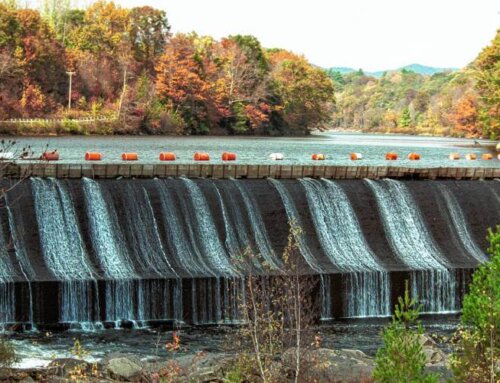August 22, 2012 Journal Excerpt:
At Sumner Falls, we pulled over to the west bank to scout out the portage around the falls and check out the falls themselves. A fellow whom I’ll call “Rapids Roy” noticed we were scouting out the rapids. Perhaps in his early 30s, he was fishing, but approached us to offer some advice. He said he had kayaked the falls a number of times, but he recommended we not try to shoot the rapids. (They consisted of several rock channels and chutes of water with ledges dropping 15 – 20 feet over a distance of perhaps 200 yards. Lots of whirlpools and pooled pockets of water presented “traps” of a sort despite a vigorous flow of water and several drops into standing waves. The guidebook said these could become Class 4 rapids in the spring, but at this low water period, they were probably nearer a Class 1-2 rating.)
Rapids Roy said big shelves and drops pushed the water in surprisingly strong and erratic ways, and if we didn’t turn properly and quickly enough, our canoe would be caught sidewise on a ledge and rolled over, or we would be pitched into an eddy from which it would be hard to escape without being capsized. Mindful of this dour prognosis as well as the chilling site of a nearby stone memorial to a person who had drowned while running the rapids a few years earlier, we paused. But then intrepid Ben, having taken on board all this forbidding advice, found it a compelling reason to scout the rapids for himself. Off he went out onto the large field of stone ledges to identify which channels of the rapids might be most navigable. He returned with the verdict: “We can do this.” (By which, I suspect he really meant, “You can do it.”) Of course the caveat was that we could do it if we tracked just the right line through the fast water.
So, we returned to our canoe, lashed down our packs and spare paddles, donned our PDFs and prepared to shoot the rapids! We entered a deep, fast moving channel of water, and then took a sharp turn to line up for the first descent. The water was moving so fast that I applied too much rudder, and the stern almost went under water before I could correct our course. But we headed straight for a large ledge and successfully over into a drop of standing waves. The drop was enough to cause water to come over the bow and gunnels so that we shipped quite a bit of water, but fortunately, we found slow water ahead and managed to beach the canoe to bail it out before proceeding further.
From there we took a second run at a notch of heavy water going over another ledge. We tracked the main current to the left hand side of its flow, then turned gradually right to conform to its bending pattern. Just as we approached a large boulder to the left of us (and before our “gateway” notch), Ben in the bow powered forward to try to fully match the current’s velocity and I in stern did a hard left rudder to pry us around the boulder and align us for a straight-ahead drop into another batch of standing waves. We shot through, and this time had enough momentum to avoid shipping water. Perfect!! Ben and I were both stoked!!! And everything thereafter – even some fast water rips, channels, and “rock sledding” as we left the area seemed tame by comparison.









